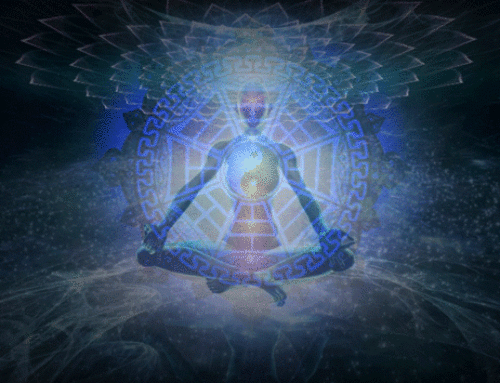Tantra is often associated with sacred sex. The ancient Sanskrit word tantra literally means “warp and woof” or “continuation” and refers to non-duality, interwovenness, or oneness through the union of opposites.
Tantra is an ancient, esoteric Indian spiritual tradition, common to both Hinduism and Buddhism, dating back to before the time of Christ–and even the Buddha, who lived in the sixth century B.C.E. Buddha is said to have transmitted Tantric teachings to his disciples. Both Hindu and Buddhist Tantric traditions emphasize the cultivation of enlightened consciousness, divine oneness, and the burning off of blockages and defilements that cover and inhibit the inner radiance of our own original nature or innate state of perfection. Classic Tantric Buddhist texts, such as an ancient, anonymous manual called “The Union of the Sun and Moon,” reveal how to utilize the right and left psychic energy channels (nadis)–which, in yogic physiology, embody the masculine (solar) and feminine (lunar) energies within our own bodies. As a result, we can become more integrated, awaken our inner energy, and thus experience wholeness.
Most Tantric practices involve no sex, and Tantric yoga is best practiced under the guidance of an experienced and qualified teacher.
In Tibetan Buddhism, or Vajrayana, the term refers to various kinds of texts (medical, astrological Tantras, etc.) and more generally to the systems of meditation of our tradition. There are four classes of these esoteric texts and treatises, and they form the heart of Tibetan Buddhism. Thus Vajrayana Buddhism is also known in Tibetan as Tantrayana, or the Tantric vehicle to enlightenment.
Today the term Tantra is sometimes misunderstood or even misused in the West. Made out to be synonymous with eroticism and licentiousness, there are myriad books and websites claiming to help students harness the Tantric teachings as a means to great sex and financial success. There are even commercial relationship workshops promising better sex through sensual Tantric training. But most Tantric practices involve no sex, and Tantric yoga is best practiced under the guidance of an experienced and qualified teacher.
Of course, sexuality is a healthy part of life, and the sexual drive is one of the most powerful energies in us. Although Western religions seem to have lost touch with the wisdom of the body and the sacred dimension of sexual energy, Tantric adepts through millennia have worked to find ways in which to integrate that energy into spiritual practice, and turn this powerful force into rocket-fuel-like propellant on the path of spiritual ecstasy and transcendence. In ancient India, this became the practice known as sacred sex, practiced with a certain amount of ritual and using specific ritual sexual practices, including maithuna–coupling with minimal movement, and holding of or even abstaining from orgasm in order to increase self-control and to purify desire.
This practice–given the right intention, training, guidance, concentration, and conditions–can sublimate and transmute sexual drive into higher, more spiritual aspirations. Through practices known as seminal retention, “melting and blazing,” the “all-consuming fire of total embrace,” “mystic heat,” and so forth, advanced practitioners have been able to redirect the release of energy upward through the body, opening all the chakras in continuous waves of full-body, orgasm-like bliss and consciousness. Quite a contrast–in purpose and experience–to the more typical, brief, downward-releasing sexual climax, usually followed by dullness and sleep.
This transformation of energy is Tantra’s capacity for developing samadhi (concentrative absorption), expanding consciousness, and opening into meditation. More than 1,000 years ago, the yogis of Bengal and Orissa in India developed this spiritual art, and a few still practice it in an underground fashion, as do the Tantric yogis and lamas of Tibetan Buddhism, where it still continues in the fullest form today.
Many Tantric practices, do not involve a literal union of two people, though they are based in the symbolic synthesis of male and female, solar and lunar, compassion and wisdom. One such fundamental aspect of Tantric practice is Tantric medicine, an ancient methodology for healing both body and soul. Working with the so-called “subtle” body, which includes the various “sheaths” or dimensions of our being from corporeality on up, Tantric medicine employs diet, fasting, breath and energy practices, initiations, visualizations, mantras, mudras (ritual gestures), and yoga, along with a knowledge of the body’s chakras and subtle energy (prana) channels to remove blockages and correct damage. By purifying the body along with the energy, the mind, and the spirit, this process can strengthen the immune system and prevent disease and mental imbalance and instability, and promote longevity, vitality, and spiritual and emotional development.
Tantric medicine can be found today in the Indian Ayurveda tradition as well as in the Buddhist treatises known as the Medical Tantras in the Tibetan tradition. Tibetans say that Buddha appeared in the form of the healing Buddha, or “Bhaishajya-guru Buddha,” who symbolizes the healing or perfecting quality of dharma, and taught the Five Medical Tantras to qualified disciples, from which all of Tibetan medicine is derived.
In the universe of Tibetan Buddhism, the continuum of Tantric spiritual development is seen as having three categories: ground, path, and fruition. The ground is the practitioner, the path is the path of meditation, which purifies this ground, and the fruition is the blissful, unified state that arises as an effect of Tantric practice. So forget IPOs and hot sex. When the body and mind become aligned and peaceful, as with Tantric medicine, that’s fruition in the true sense of the word.






